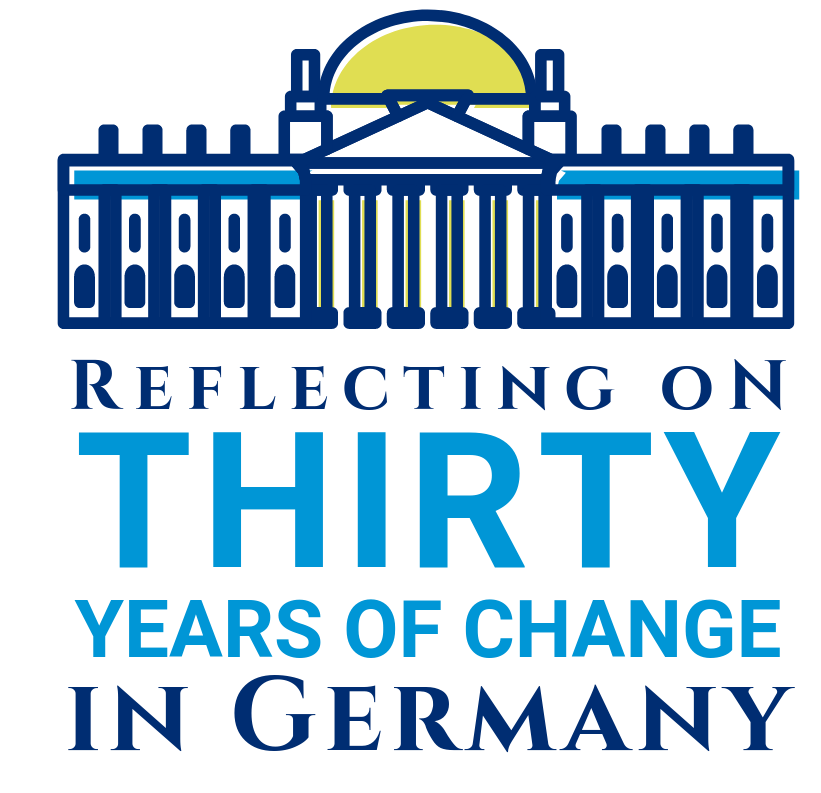
Roland Witschel/picture alliance via Getty Images
Embarking on a New Path of Partnership: Thirty Years after the Fall of the Berlin Wall

Jeff Rathke
President of AGI
Jeffrey Rathke is the President of the American Institute for Contemporary German Studies at the Johns Hopkins University in Washington, DC.
Prior to joining AICGS, Jeff was a senior fellow and deputy director of the Europe Program at CSIS, where his work focused on transatlantic relations and U.S. security and defense policy. Jeff joined CSIS in 2015 from the State Department, after a 24-year career as a Foreign Service Officer, dedicated primarily to U.S. relations with Europe. He was director of the State Department Press Office from 2014 to 2015, briefing the State Department press corps and managing the Department's engagement with U.S. print and electronic media. Jeff led the political section of the U.S. Embassy in Kuala Lumpur from 2011 to 2014. Prior to that, he was deputy chief of staff to the NATO Secretary General in Brussels. He also served in Berlin as minister-counselor for political affairs (2006–2009), his second tour of duty in Germany. His Washington assignments have included deputy director of the Office of European Security and Political Affairs and duty officer in the White House Situation Room and State Department Operations Center.
Mr. Rathke was a Weinberg Fellow at Princeton University (2003–2004), winning the Master’s in Public Policy Prize. He also served at U.S. Embassies in Dublin, Moscow, and Riga, which he helped open after the collapse of the Soviet Union. Mr. Rathke has been awarded national honors by Estonia, Latvia, and Lithuania, as well as several State Department awards. He holds an M.P.P. degree from Princeton University and B.A. and B.S. degrees from Cornell University. He speaks German, Russian, and Latvian.
__
On Saturday, we mark the 30th anniversary of the fall of the Berlin Wall. It was one of the most momentous political developments in a generation—the climax of the peaceful uprising that brought freedom to 17 million East Germans and led to the unification of Germany less than twelve months later. A round anniversary of a joyous event leaves us prone to nostalgia, especially when the images of November 9, 1989 are so easy to recall, with jubilant crowds atop the Berlin Wall, literally surmounting and shattering the edifice of their division and oppression. That is all the more reason to pause and consider the deeper roots and the sacrifice inherent in the toppling of communism in central and eastern Europe in 1989, and why the United States’ relationship with Germany has been central to American goals in Europe and more broadly for seventy years.
Read more on the Fall of the Berlin Wall from AGI
 It was a miraculous year, 1989, which saw more than 100 million people in Europe gain their freedom. They did so principally through their own courage and determination, but they were inspired by the possibilities that were apparent on the other side of their continent: democracy, human rights, and prosperity. Their triumph was precarious and appears inevitable only in retrospect. In East Germany, from September through the end of October, Monday protests in Leipzig had exploded from a few thousand people to 300,000 participants. Their example was infectious, with tens of thousands demonstrating in other cities. On November 4, half a million people took to the streets in East Berlin. The East German authorities did not use force against protesters, but some regime figures supported the Chinese approach to crushing the Tiananmen Square protests earlier that summer, and official restraint was not guaranteed. In the face of that ominous uncertainty, the brave citizens of Leipzig and across East Germany reminded the world that true courage is action when you are unsure whether you will prevail. Their courage, despite unpredictable outcomes, is something to cherish and celebrate.
It was a miraculous year, 1989, which saw more than 100 million people in Europe gain their freedom. They did so principally through their own courage and determination, but they were inspired by the possibilities that were apparent on the other side of their continent: democracy, human rights, and prosperity. Their triumph was precarious and appears inevitable only in retrospect. In East Germany, from September through the end of October, Monday protests in Leipzig had exploded from a few thousand people to 300,000 participants. Their example was infectious, with tens of thousands demonstrating in other cities. On November 4, half a million people took to the streets in East Berlin. The East German authorities did not use force against protesters, but some regime figures supported the Chinese approach to crushing the Tiananmen Square protests earlier that summer, and official restraint was not guaranteed. In the face of that ominous uncertainty, the brave citizens of Leipzig and across East Germany reminded the world that true courage is action when you are unsure whether you will prevail. Their courage, despite unpredictable outcomes, is something to cherish and celebrate.
Rather than engaging in a diplomatic victory dance, Bonn and Washington acted with restraint, imagination, and vision, setting a path to overcome the division of Germany while the opportunity presented itself.
Equally significant was the response of West German and American leaders to the astonishing spectacle of the fall of the Berlin Wall. Rather than engaging in a diplomatic victory dance, Bonn and Washington acted with restraint, imagination, and vision, setting a path to overcome the division of Germany while the opportunity presented itself, because no one knew how long the window would remain open.
The success of transatlantic leaders in consolidating the gains of 1989 had its roots in 1949, when three momentous events in the short span of seven weeks shaped the transatlantic bond as we know it today: the creation of NATO; the success of the Berlin Airlift; and the founding of the Federal Republic of Germany. They were the manifestation of an American commitment based on the recognition that the future of the United States was indivisible from the future of Europe. Despite the very real American desire in the mid-1940s to turn inward and retreat from global leadership, the United States created a network of alliances and mutual obligations to promote peace and defend our common interests. This commitment became a community of values and defined American engagement for seventy years. The U.S. approach would have been meaningless without the West German public and political leadership, which pursued reconciliation and partnership anchored in the West. The Federal Republic of Germany was the crucial element for generations of U.S. leaders, from Truman and Eisenhower and onward.
The U.S. approach would have been meaningless without the West German public and political leadership, which pursued reconciliation and partnership anchored in the West.
It took four decades for the ultimate vindication of the commitment forged in 1949. The sustained focus of the United States and its allies over that time was only possible because it was based on clearly defined goals that were understood by successive generations of leaders, and the confidence that comes from shared principles.
We should therefore pause and ask what objectives we are pursuing together now that are similarly grounded, so that we will be able to sustain them for forty years. What political and economic goals have we articulated that will guide our course to the middle of this century and beyond? How do we provide for our security in the face of new and old threats? How do we ensure prosperity and update the international rules and standards? And how do we nurture collaboration on the political and social problems that confront us? As we reflect with pride on the accomplishments of the U.S.-German partnership, we must rededicate ourselves to applying its principles to the challenges of today and of the future.









